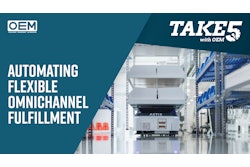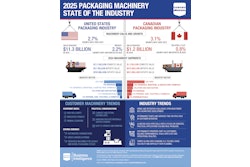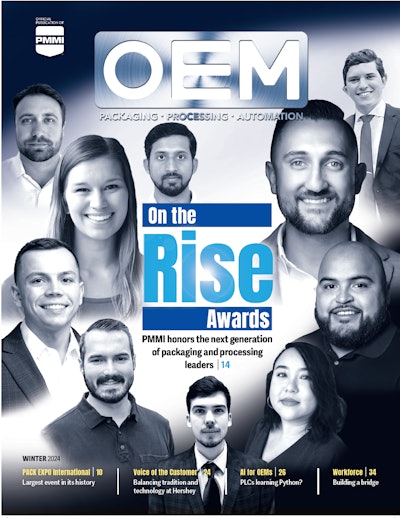Quick hits:
As the industry faces unprecedented labor shortages and supply chain issues, OEMs need to make strategic moves and plans to differentiate their offerings, meet evolving end-user demands, and diversify their business model.
These are the spaces OEMs should be eyeing and forming partnerships around in 2022
- Digitization
- Machine-as-a-service
- Supply Chain
- Robotics
- Harpak-ULMA: The Innovator
- Pearson Packaging Offers Machine-as-a-Service
- Video: How Robotic Palletizers Cater to Labor Shortage at PACK EXPO Las Vegas
 | Read the transcript below: |
Welcome to Take Five with OEM, I’m Natalie Craig, Managing Editor of OEM Magazine.
Everything as we know it is about to change. As the industry faces unprecedented labor shortages and supply chain issues, OEMs need to make strategic moves and plans to differentiate their offerings, meet evolving end-user demands, and diversify their business model.
But they don’t need to go the route of innovation alone. Having a strategic partner can help OEMs bridge technology gaps, create new revenue streams, and develop solutions that meet the dire needs of the industry.
At PMMI’s annual Top to Top Summit, where end-users and OEMs gathered to discuss the state of the industry and key challenges that lie ahead, the main pain point for everyone in the room was the ability to grow their company amid a labor shortage. And the top priorities for the next 12 months were found to be workforce, automation, productivity, and supply chain, in that order.
In the report, there was also a large emphasis put on partnerships between OEMs, end-users, and technology suppliers.
I recently spoke to OEMs and their strategic partners about how they are teaming up to create lucrative partnerships that move the industry forward while also addressing the key challenges mentioned in the Top to Top report.
And we are back! I mentioned that there are four areas of innovation that lend themselves well to partnerships for OEMs. So let’s dive in.
The first area is digitization. The digitization of manufacturing is creating new ways in which equipment is designed, maintained, and operated. I spoke with Rockwell about how they are helping bridge information technology (IT) with operation technology (OT) to help OEMs develop and discover new service opportunities, and ways to access their equipment data remotely.
In recent years, OEMs have explored different business models when it comes to how they sell and service equipment, including the Machine-as-a-Service (MaaS) model.
The MaaS model allows OEMs to lease equipment to end-user customers for a specified time and collect payment based on the machine’s output and agreed-upon targets. When it comes time for maintenance and services, OEMs charge their customers a subscription fee.
One of the platforms that have allowed companies to deploy standardized MaaS business models is SteamChain.io. The company’s automated process engine uses IoT and blockchain, an immutable digital ledger, to access the data from equipment, which is then used to create and send financial transactions back to the OEM.
RŌBEX, an industrial robot system integrator, sells a lot of its equipment into distribution centers where a variety of package shapes and sizes are handled, which can potentially provide many obstacles for the robot and require more oversight from operators.
Today, end-users are looking for equipment that is highly automated and needs as little operator involvement as possible due to the extreme labor shortage. With this demand in mind, RŌBEX has partnered with AI-powered vision software manufacturer Plus One Robotics to improve robotic eye-hand coordination, boosting productivity capabilities in warehouses and distribution centers.
To that end, RŌBEX is leveraging Plus One Robotics’ Yonder product, which is a remote supervisor software suite that leverages live remote support and bridges the technology and skills gap. It accomplishes this by allowing robots to ask for help—via the software’s human-in-the-loop feature—when the robot encounters a package format that it isn’t sure how to pick, place, or palletize. A “Crew Chief” can then instantly see what the robot sees and instruct it on how to handle the package. The robot resumes its operation and the AI in the software teaches the robot how to adapt to similar scenarios in the future.
A strained supply chain puts OEMs in an incredibly tough spot as access to raw materials can be hindered due to shortages, causing longer lead times for end-users.
During PMMI’s Top to Top meeting, one OEM cited serious supply chain issues as the main reason for extended lead times.
In response, a CPG suggested OEMs need to be more creative with machine design and that they should use alternative components when supply chain issues cause delays.
So, how do OEMs focus on doing what they're good at—designing machines and solutions—while also becoming supply chain experts?
Infor suggests digitalizing end-to-end supply chain processes so that they can have real-time visibility to make those decisions that could positively impact lead times or improve transparency when supply chain issues arise.
You can read extensively about each of these areas and the specifics of how OEMs are partnering with suppliers to innovate by visiting oemgo.to/newpartnerships.



















